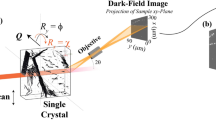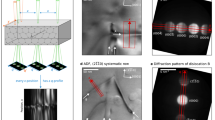Abstract
RELATIVELY little electron transmission microscopy has been performed on the harder ceramics (compared with that on metals and on the softer materials such as sodium chloride and talc). The work that has been done has mostly been confined to those materials that cleave readily; magnesium oxide, for example. Materials such as quartz and alumina have proved difficult to prepare in sections thin enough to be electron transparent. Drum1 has thinned alumina by sputtering, but the process of annealing out the resultant surface damage appears to alter the dislocation configuration.
This is a preview of subscription content, access via your institution
Access options
Subscribe to this journal
Receive 51 print issues and online access
$199.00 per year
only $3.90 per issue
Buy this article
- Purchase on Springer Link
- Instant access to full article PDF
Prices may be subject to local taxes which are calculated during checkout
Similar content being viewed by others
References
Drum, C. M., Atomic Energy Res. Est. Rep., No. 4563.
Tighe, N. J., Rev. Sci. Instr., 35, (4), 520 (1964).
Barber, D. J. (private communication).
Hirsch, P. B., Howie, A., and Whelan, M. J., Phil. Trans. Roy. Soc., A, 252, 499 (1960).
Wachtmann, J. B., Barber, D. J., and Tighe, N. J. (private communication).
Kronberg, M. L., Acta Met., 5, 507 (1957).
Kronberg, M. L. (private communication).
Author information
Authors and Affiliations
Rights and permissions
About this article
Cite this article
EVANS, P., HARDIMAN, B. Direct Observation of Dislocations in Alumina. Nature 206, 182–183 (1965). https://doi.org/10.1038/206182a0
Issue Date:
DOI: https://doi.org/10.1038/206182a0
This article is cited by
-
Dislocations in Naturally Deformed Quartzite
Nature Physical Science (1971)
Comments
By submitting a comment you agree to abide by our Terms and Community Guidelines. If you find something abusive or that does not comply with our terms or guidelines please flag it as inappropriate.



